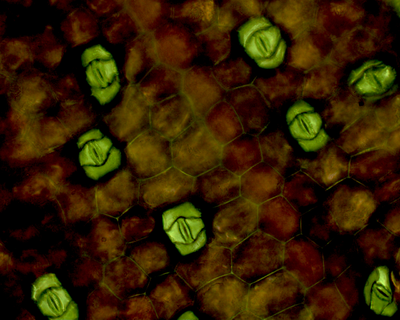Difference between revisions of "Stoma"
| Line 28: | Line 28: | ||
: 10. [[Carbon Dioxide]] can now get into the [[leaf]]. | : 10. [[Carbon Dioxide]] can now get into the [[leaf]]. | ||
: 11. [[Photosynthesis]] starts again using up the [[water]]. | : 11. [[Photosynthesis]] starts again using up the [[water]]. | ||
| + | |||
| + | ===References=== | ||
| + | ====AQA==== | ||
| + | |||
| + | :[https://www.amazon.co.uk/gp/product/0008158754/ref=as_li_tl?ie=UTF8&camp=1634&creative=6738&creativeASIN=0008158754&linkCode=as2&tag=nrjc-21&linkId=27ad53b0283feeff7fc5ae04a9e205f531 ''Stomata, page 55, GCSE Biology; Student Book, Collins, AQA ''] | ||
| + | :[https://www.amazon.co.uk/gp/product/1782945598/ref=as_li_tl?ie=UTF8&camp=1634&creative=6738&creativeASIN=1782945598&linkCode=as2&tag=nrjc-21&linkId=ad276ad49df77ab4b40ab4fd0fe10321 ''Stomata, pages 22, 38, 40, GCSE Combined Science; The Revision Guide, CGP, AQA ''] | ||
| + | :[https://www.amazon.co.uk/gp/product/0198359373/ref=as_li_tl?ie=UTF8&camp=1634&creative=6738&creativeASIN=0198359373&linkCode=as2&tag=nrjc-21&linkId=952a73bbb09d222ecc4b50d200679849 ''Stomata, pages 23, 66-68, GCSE Biology; Third Edition, Oxford University Press, AQA ''] | ||
| + | :[https://www.amazon.co.uk/gp/product/0008158762/ref=as_li_tl?ie=UTF8&camp=1634&creative=6738&creativeASIN=0008158762&linkCode=as2&tag=nrjc-21&linkId=a0fffa35b3ea49a63404f6704e0df7cc ''Stomata, pages 297, 301, GCSE Chemistry; Student Book, Collins, AQA ''] | ||
| + | :[https://www.amazon.co.uk/gp/product/1782946381/ref=as_li_tl?ie=UTF8&camp=1634&creative=6738&creativeASIN=1782946381&linkCode=as2&tag=nrjc-21&linkId=5ec5fc3f6429e30c1d9ab9bca2bccf93 ''Stomata, pages 60, 86, 88, 89, GCSE Combined Science Trilogy; Biology, CGP, AQA ''] | ||
| + | :[https://www.amazon.co.uk/gp/product/0008158754/ref=as_li_tl?ie=UTF8&camp=1634&creative=6738&creativeASIN=0008158754&linkCode=as2&tag=nrjc-21&linkId=27ad53b0283feeff7fc5ae04a9e205f532 ''Stomata, pages 60-1, 68, 70-1, GCSE Biology; Student Book, Collins, AQA ''] | ||
| + | :[https://www.amazon.co.uk/gp/product/1782945954/ref=as_li_tl?ie=UTF8&camp=1634&creative=6738&creativeASIN=1782945954&linkCode=as2&tag=nrjc-21&linkId=100574c08fbbb64318256eb79ed61a76 ''Stomata, pages 66, 92, 94, 95, GCSE Biology, CGP, AQA ''] | ||
| + | :[https://www.amazon.co.uk/gp/product/1471851354/ref=as_li_tl?ie=UTF8&camp=1634&creative=6738&creativeASIN=1471851354&linkCode=as2&tag=nrjc-21&linkId=9012a0d354024419214fb3ad5ac44ba0 ''Stomata, pages 68-9, GCSE Combined Science Trilogy 1, Hodder, AQA ''] | ||
| + | :[https://www.amazon.co.uk/gp/product/1782945563/ref=as_li_tl?ie=UTF8&camp=1634&creative=6738&creativeASIN=1782945563&linkCode=as2&tag=nrjc-21&linkId=9a1d023a374038e6072f33c4f3cf808b ''Stomata, pages, 25, 44, GCSE Biology; The Revision Guide, CGP, AQA ''] | ||
Revision as of 15:47, 13 November 2019
Key Stage 3
Meaning
Stomata are holes in the leaf that can open and close to allow or stop gas exchange in the leaf.
| The under side of a leaf showing guard cells and stomata. |
About Stomata
- There are usually more stomata on the underside of a leaf than the top side.
- Stomata close when the leaf becomes dehydrated. This stops photosynthesis, which needs water, so it helps stop the dehydration from getting worse.
The Process:
- 1. Plant becomes dehydrated.
- 2. Guard Cells become flaccid.
- 3. Stomata close.
- 4. Carbon Dioxide can no longer enter the leaf.
- 5. Photosynthesis stops.
- 6. Respiration continues to make water and water is taken up by the roots.
- 7. Plant becomes hydrated again.
- 8. Guard Cells become turgid.
- 9. Stomata open.
- 10. Carbon Dioxide can now get into the leaf.
- 11. Photosynthesis starts again using up the water.
References
AQA
- Stomata, page 55, GCSE Biology; Student Book, Collins, AQA
- Stomata, pages 22, 38, 40, GCSE Combined Science; The Revision Guide, CGP, AQA
- Stomata, pages 23, 66-68, GCSE Biology; Third Edition, Oxford University Press, AQA
- Stomata, pages 297, 301, GCSE Chemistry; Student Book, Collins, AQA
- Stomata, pages 60, 86, 88, 89, GCSE Combined Science Trilogy; Biology, CGP, AQA
- Stomata, pages 60-1, 68, 70-1, GCSE Biology; Student Book, Collins, AQA
- Stomata, pages 66, 92, 94, 95, GCSE Biology, CGP, AQA
- Stomata, pages 68-9, GCSE Combined Science Trilogy 1, Hodder, AQA
- Stomata, pages, 25, 44, GCSE Biology; The Revision Guide, CGP, AQA
